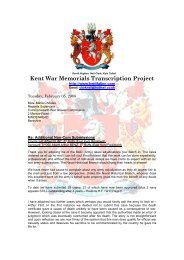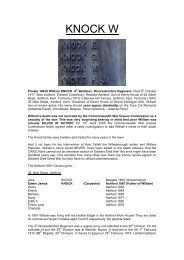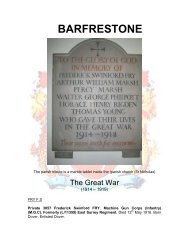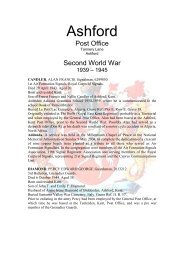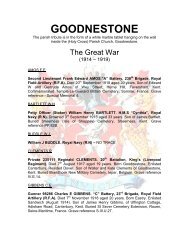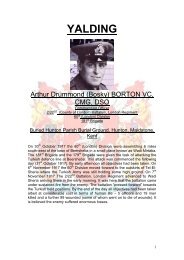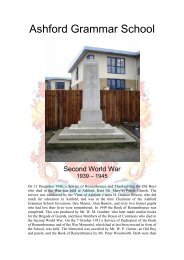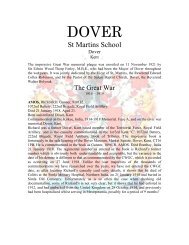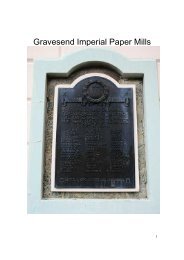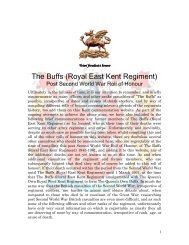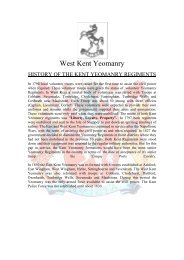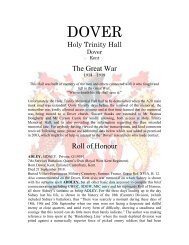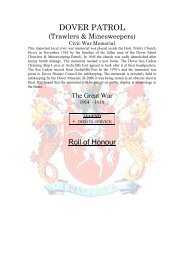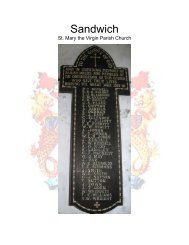JOHNSON MEMORIAL HAMSTREET - Kent Fallen
JOHNSON MEMORIAL HAMSTREET - Kent Fallen
JOHNSON MEMORIAL HAMSTREET - Kent Fallen
Create successful ePaper yourself
Turn your PDF publications into a flip-book with our unique Google optimized e-Paper software.
1st Lt. William H. Johnson<br />
Memorial - Hamstreet<br />
The memorial and the surrounding as shown in the photograph above, was<br />
erected and established to honour the memory of 23 year old 1st Lieutenant<br />
William H. Johnson of the U.S.A.A.F. who sacrificed his life on Thursday 13<br />
April 1944. William was the pilot of a Boeing B-17 Flying Fortress, serial<br />
number 42-31719 of the 711th Bombardment Squadron, 447th Bombardment<br />
Group, United States Army Air Force. At the time of his death William’s<br />
squadron was based at U.S.A.A.F. Station No.125, Rattlesden, Bury St.<br />
Edmunds, Suffolk. Following the crew briefing which had been at 0800 hours,<br />
William’s aircraft was one of 243 B-17’s which were taking part in a raid to<br />
bomb the Messerschmitt aircraft plant at Augsburg in Bavaria southern<br />
Germany. The American bombers taking part in the raid were loaded with<br />
170 General Purpose and 226 incendiary bombs. The bombing altitude of<br />
22,000 feet was reached as the Group crossed the French coast.<br />
Approximately 100 miles from the French coast the bombers came under<br />
heavy, accurate flak fire which caused a number of planes to abort and head<br />
home, including William’s aircraft having suffered heavy damage. Once the<br />
1
Flying Fortress was over the <strong>Kent</strong> coast at Hythe, William ordered his crew<br />
to bale out from their stricken aircraft, but he took decision to attempt to<br />
crash land his aircraft. As he crossed the Romney Marsh and approaching the<br />
village of Hamstreet, William realised that his B-17 was going to crash into<br />
the village, and in order to avoid the inevitable loss of life amongst the local<br />
population, he sacrificed his own life by crashing the huge bomber to the<br />
south of the village. During the raid, 18 B-17s were lost, 2 damaged beyond<br />
repair and 178 damaged. The initial U.S.A.A.F. casualties for the Augsburg<br />
raid were recorded as 3 killed, 16 wounded and 170 missing, the number of<br />
fatalities increased when recorded on later data. William and all of those lost<br />
on the same raid are commemorated in the illuminated American Roll of<br />
Honour Book 1941-1946 in St. Pauls Cathedral, London, in which is inscribed<br />
the names of those Americans serving with the Canadian, British and United<br />
States Armed Forces, who gave their lives while en-route to or while<br />
stationed in the United Kingdom. It also includes those members of units<br />
permanently based in the United Kingdom who made the supreme sacrifice<br />
between D-Day and VE-Day. At the time of his death William and his crew<br />
who are named below, had flown together on 20 bombing raids to Germany:-<br />
2nd Lieutenant Harold W. Whitely Co-Pilot, of Limerick, Maine, U.S.A.<br />
2nd Lieutenant William S. Fancher Navigator, of Walton, New York, U.S.A.<br />
2nd Lieutenant George H. Ney, Bombadier,<br />
Technical Staff Sergeant John A. Higgins, Radio Operator, of Kew Gardens,<br />
Long Island, New York, U.S.A.<br />
Technical Staff Sergeant Kenneth L. Zieger, Ball Turret Gunner, of<br />
Mishawaka, Indiana, U.S.A.<br />
Technical Sergeant Elbert J. Williams, Left Waist Gunner, of Kansas City,<br />
Montana, U.S.A.<br />
Technical Sergeant Paul E. Simpson, Right Waist Gunner.<br />
Technical Staff Sergeant Peter Bartkus, Tail Gunner, of Lowell,<br />
Massachusetts, U.S.A.<br />
Technical Sergeant Frank J. Hazzard, Top Turret Gunner.<br />
The latter member of the crew, Technical Sergeant Frank J. Hazzard, of 2541<br />
Belden Avenue, Chicago, Illinois, U.S.A., submitted the following report. “For<br />
about twenty minutes after we hit the French coast and were well on our way<br />
to Augsburg everything went along smoothly but then suddenly all hell began<br />
to break loose. A terrific explosion sounded directly beneath my turret, I<br />
knew we had been hit pretty badly because I heard the co-pilot saying that he<br />
was going to feather number four engine and that number three was out also.<br />
The power line in my top turret was hit also, rendering my guns useless. All<br />
four officers had been wounded by the flak so I proceeded to the cockpit to see<br />
if there were anything I could do. The co-pilot had been hit in the arm rather<br />
badly; I cut his sleeve open and bandaged his wrist and arm. The pilot had<br />
been hit also in the back of the neck but he told me to take care of the<br />
navigator first. I then went to the nose of the ship and saw that the navigator<br />
2
had been hit in the leg. I slit open his trouser leg; the wound was bleeding<br />
very badly and I knew he must have been in great pain but all the time I was<br />
working on his leg he stood up and continued to navigate the ship. The<br />
bombardier had also been hit in the arm but the cut was not bleeding so I<br />
figured that he would be OK. About this time the co-pilot called and asked me<br />
to transfer the fuel from number four to number one engine. This done I<br />
proceeded to throw all my ammunition and ammunition boxes, flak helmet,<br />
and other moveable equipment out of the plane in order to lighten the load. I<br />
went to the nose and did the same thing there. About this time we were hit<br />
again and number one engine went out. We were flying on one engine and<br />
losing altitude and flying speed all the time. I guess we were in a pretty bad<br />
spot but I was too busy running from my turret to the nose to the cockpit and<br />
back again to think too much about it. "Down in the nose I put another<br />
bandage on the navigator's leg. By this time I knew the leg must have been<br />
paining him horribly but he still continued to navigate the ship. He did a<br />
wonderful job, in my opinion he deserves a lot of the credit for getting us<br />
home. When we hit the channel we were flying at 8,000 feet, when we finally<br />
reached the English coat we were at 1500 feet. Just as I was thinking that we<br />
were going to make it back home in one piece, I felt the ship vibrating<br />
something awful, looking out of my window I saw that she was on fire. I was<br />
in the nose at the time, tapping the navigator on the shoulder I showed him<br />
the fire. He nodded his assent. I then went back to the pilot's compartment, I<br />
saw the Bombardier on the catwalk of the bomb bay looking for his chute. I<br />
remembered that he had left it in my turret position so I immediately went<br />
there and got the chute since the Bombardier because of his wounded arm<br />
couldn't get the chute on I snapped it on for him and assisted him in getting<br />
out of the plane through the open bomb bay. By this time I thought everyone<br />
outside of the pilot and myself had left the ship, I looked towards his seat and<br />
saw him getting up preparing to jump. Later on I found out that he had never<br />
gotten out of the plane but had been killed when it crashed about a half mile<br />
from where I jumped. We were now at 800 feet so I figured it was high time<br />
for me to get the hell out of the plane. I went out through the bomb bay.<br />
When I landed I saw the co-pilot a few feet away. The first thing he said to<br />
me was, 'Combat's rough, you can get hurt at this sort of thing.' It struck me<br />
very funny at the moment but I guess there's nothing very humorous about<br />
what we went through. If it hadn't been for the courage and skill of our pilot<br />
in bringing the ship home the wreck it was on one engine; and for the<br />
wonderful job done by our navigator even though he was in constant pain and<br />
weak through loss of blood, we never could have made it back.” During the<br />
mid 1990’s the village of Hamstreet finally got a bypass, during the<br />
construction of which a new road junction was formed on land owned by J.W.<br />
Goddard & Sons of Ham Mill Farm, Hamstreet, who also owned the ground<br />
where William had died on Thursday 13 April 1944. The above road junction<br />
was named “Johnsons Corner” in rememberance of William H. Johnson.<br />
3
1st LIEUTENANT WILLIAM H. <strong>JOHNSON</strong> U.S.A.A.F.<br />
Minneapolis, Minnesota, U.S.A.<br />
4
Memorial Plaque at the centre of the William H. Johnson Memorial.<br />
5



